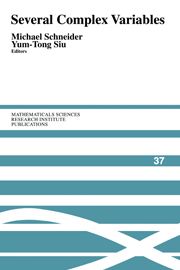Book contents
- Frontmatter
- Contents
- Preface
- Local Holomorphic Equivalence of Real Analytic Submanifolds in ℂN
- How to Use the Cycle Space in Complex Geometry
- Resolution of Singularities
- Global Regularity of the ∂-Neumann Problem: A Survey of the L2-Sobolev Theory
- Recent Developments in the Classification Theory of Compact Kahler Manifolds
- Remarks on Global Irregularity in the ∂-Neumann Problem
- Subelliptic Estimates and Finite Type
- Pseudoconvex-Concave Duality and Regularization of Currents
- Complex Dynamics in Higher Dimension
- Attractors in ℙ2
- Analytic Hilbert Quotients
- Varieties of Minimal Rational Tangents on Uniruled Projective Manifolds
- Recent Developments in Seiberg-Witten Theory and Complex Geometry
- Recent Techniques in Hyperbolicity Problems
- Rigidity Theorems in Kahler Geometry and Fundamental Groups of Varieties
- Nevanlinna Theory and Diophantine Approximation
Nevanlinna Theory and Diophantine Approximation
Published online by Cambridge University Press: 25 June 2025
- Frontmatter
- Contents
- Preface
- Local Holomorphic Equivalence of Real Analytic Submanifolds in ℂN
- How to Use the Cycle Space in Complex Geometry
- Resolution of Singularities
- Global Regularity of the ∂-Neumann Problem: A Survey of the L2-Sobolev Theory
- Recent Developments in the Classification Theory of Compact Kahler Manifolds
- Remarks on Global Irregularity in the ∂-Neumann Problem
- Subelliptic Estimates and Finite Type
- Pseudoconvex-Concave Duality and Regularization of Currents
- Complex Dynamics in Higher Dimension
- Attractors in ℙ2
- Analytic Hilbert Quotients
- Varieties of Minimal Rational Tangents on Uniruled Projective Manifolds
- Recent Developments in Seiberg-Witten Theory and Complex Geometry
- Recent Techniques in Hyperbolicity Problems
- Rigidity Theorems in Kahler Geometry and Fundamental Groups of Varieties
- Nevanlinna Theory and Diophantine Approximation
Summary
AS observed originally by C. Osgood, certain statements in value distribution theory bear a strong resemblance to certain statements in diophantine approximation, and their corollaries for holomorphic curves likewise resemble statements for integral and rational points on algebraic varieties. For example, if X is a compact Riemann surface of genus > 1, then there are no non-constant holomorphic maps f : ℂ → X; on the other hand, if X is a smooth projective curve of genus > 1 over a number field k, then it does not admit an infinite set of /c-rational points. Thus non-constant holomorphic maps correspond to infinite sets of k-rational points.
This article describes the above analogy, and describes the various extensions and generalizations that have been carried out (or at least conjectured) in recent years.
When looked at a certain way, certain statements in value distribution theory bear a strong resemblance to certain statements in diophantine approximation, and their corollaries for holomorphic curves likewise resemble statements for integral and rational points on algebraic varieties. The first observation in this direction is due to C. Osgood [1981]; subsequent work has been done by the author, S. Lang, P.-M. Wong, M. Ru, and others. To begin describing this analogy, we consider two questions. On the analytic side, let X be a connected Riemann surface. Then we ask:
QUESTION 1. Does there exist a non-constant holomorphic map f : ℂ → X
Information
- Type
- Chapter
- Information
- Several Complex Variables , pp. 535 - 564Publisher: Cambridge University PressPrint publication year: 2000
